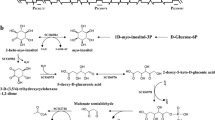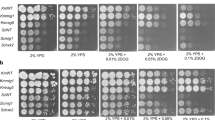Summary
The SGA1 gene encoding glucoamylase is specifically expressed late in meiotic development of the yeast Saccharomyces cerevisiae. We found that accumulation of both enzyme activity and transcripts was regulated negatively by both nutritional signals and a haploid-specific negative regulator gene of meiosis, RME1, and positively by the inducer genes for meiosis, IME1 and IME2. To study the role of sequences upstream of the SGA1 gene in its expression and regulation, we generated internal deletions in the 5′ non-coding region of the gene and chimeric genes with portions of the upstream sequence inserted into a reporter gene. By analyzing the expression of these genes, we have identified both a 19 by upstream activation sequence (UAS) and a 49 by negatively regulating element (NRE). The UAS activated transcription with no requirement for heterozygosity at the mating-type locus, but this activation was still under negative control by nutrients. The NRE showed no UAS-like activity but conferred IME2-dependent (or meiosis-specific) expression on a heterologous promoter. These results suggest that meiosis-specific expression of the SGA1 gene is established by a regulatory hierarchy including positive and negative factors, the actions of which are mediated through the two separate upstream regulatory elements, UAS and NRE, respectively. Also, that two independently acting cascades exist for the regulation of SGA1 expression: one transduces both the mating-type and nutritional signals and includes the IME2 product, which acts to relieve the repression through NRE ; and another transduces only the nutritional signal independently of the above pathway and inhibits positive factors acting on UAS.
Similar content being viewed by others
References
Broach JR, Strathern JN, Hicks JB (1979) Transformation in yeast: development of a hybrid cloning vector and isolation of the CAN1 gene. Gene 8:121–133
Cameron S, Levin L, Zoller M, Wigler M (1988) cAMP-independent control of sporulation, glycogen metabolism, and heat shock resistance in S. cerevisiae. Cell 53:555–566
Casadaban M, Martinez-Arias A, Shapira S, Chou J (1983) β-Galactosidase gene fusion for analyzing gene expression in Escherichia coli and yeast. Methods Enzymol 100:293–308
Colonna WJ, Magee PT (1978) Glycogenolytic enzymes in sporulating yeast. J Bacteriol 134:844–853
Elion W, Warner J (1984) The major promoter element of rRNA transcription in yeast lies 2 kb upstream. Cell 39:663–673
Garber AT, Segall J (1986) The SPS4 gene of Saccharomyces cerevisiae encodes a major sporulation-specific mRNA. Mol Cell Biol 6:4478–4485
Inui M, Fukui S, Yamashita I (1989) Genetic controls of STA1 gene expression in yeast. Agric Biol Chem 53:741–748
Kane SM, Roth R (1974) Carbohydrate metabolism during ascospore development in yeast.J Bacteriol 118:8–14
Kassir Y, Simchen G (1976) Regulation of mating and meiosis in yeast by the mating type locus. Genetics 82:187–206
Kassir Y, Granot D, Simchen G (1988) IME1, a positive regulator gene of meiosis in S. cerevisiae. Cell 52:853–862
Matsumoto K, Uno I, Ishikawa T (1983) Initiation of meiosis in yeast mutants defective in adenylate cyclase and cyclic AMP-dependent protein kinase. Cell 32:417–423
Maxam A, Gilbert W (1980) Sequencing end-labeled DNA with base specific chemical cleavages. Methods Enzymol 65:499–560
Mitchell AP, Herskowitz I (1986) Activation of meiosis and sporulation by repression of the RME1 product in yeast. Nature 319:738–742
Okimoto Y, Yoshimoto H, Shima H, Akada R, Nimi O, Yamashita I (1989) Genes required for transcription of STAI encoding an extracellular glucoamylase in the yeast Saccharomyces. Agric Biol Chem 53:2797–2800
Sanger F, Nicklen S, Coulson A (1977) DNA sequencing with chain-terminating inhibitors. Proc Natl Acad Sci USA 74:5463–5467
Shima H, Inui M, Akada R, Yamashita I (1989) Upstream region of the yeast glucoamylase gene which are required for efficient transcription. Agric Biol Chem 53:749–755
Smith HE, Mitchell AP (1989) A transcriptional cascade governs entry into meiosis in Saccharomyces cerevisiae. Mol Cell Biol 9:2142–2152
Strich R, Slater MR, Esposito RE (1989) Identification of negative regulatory genes that govern the expression of early meiotic genes in yeast. Proc Natl Acad Sci USA 86:10018–10022
Toda T, Uno I, Ishikawa T, Powers S, Kataoka T, Broek D, Cameron S, Broach J, Matsumoto K, Wigler M (1985) In yeast, RAS proteins are controlling elements of adenylate cyclase. Cell 40:27–36
Toda T, Cameron S, Sass P, Zoller M, Wigler M (1987) Three different genes in S. cerevisiae encode the catalytic subunits of the cAMP-dependent protein kinase. Cell 50:277–287
Yamashita I, Fukui S (1984) Secretion of Saccharomyces cerevisiae glucoamylase from Schizosaccharomyces pombe. Agric Biol Chem 48:1931–1932
Yamashita I, Fukui S (1985) Transcriptional control of the sporulation-specific glucoamylase gene in the yeast Saccharomyces cerevisiae. Mol Cell Bio1 5:3069–3073
Yamashita I, Hatano T, Fukui S (1984) Subunit structure of glucoamylase of Saccharomyces diastaticus. Agric Biol Chem 48:1611–1616
Yamashita I, Maemura T, Hatano T, Fukui S (1985 a) Polymorphic extracellular glucoamylase genes and their evolutionary origin in the yeast Saccharomyces diastaticus. J Bacteriol 161:574–582
Yamashita I, Suzuki K, Fukui S (1985b) Nucleotide sequence of the extracellular glucoamylase gene STA1 in the yeast Saccharomyces diastaticus. J Bacteriol 161:567–573
Yamashita I, Takano Y, Fukui S (1985c) Control of STA1 gene expression by the mating-type locus in yeasts. J Bacteriol 164:769–773
Yamashita I, Nakamura M, Fukui S (1987) Gene fusion is a possible mechanism underlying the evolution of STA1. J Bacteriol 169:2142–2149
Yoshida M, Kawaguchi H, Sakata Y, Kominami K, Hirano M, Shima H, Akada R, Yamashita I (1990) Initiation of meiosis and sporulation in Saccharomyces cerevisiae requires a novel protein kinase homologue. Mol Gen Genet 221:176–186
Author information
Authors and Affiliations
Additional information
Communicated by C.P. Hollenberg
Rights and permissions
About this article
Cite this article
Kihara, K., Nakamura, M., Akada, R. et al. Positive and negative elements upstream of the meiosis-specific glucoamylase gene in Saccbaromyces cerevisiae . Molec. Gen. Genet. 226, 383–392 (1991). https://doi.org/10.1007/BF00260650
Received:
Accepted:
Issue Date:
DOI: https://doi.org/10.1007/BF00260650




